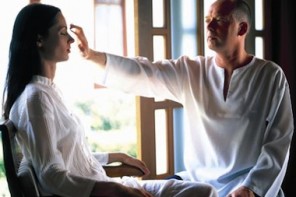As quickly as it exploded, the hype around Eat Pray Love, the bestselling spiritual-travelogue-turned-Julia-Roberts movie, has begun to fade. But don’t be fooled: while the movie has earned a disappointing(!) $47.1 million at the box office, the book behind it continues to fuel a cultural phenomenon.
Since appearing in 2006, Elizabeth Gilbert’s memoir of sensuous travel as road to personal and spiritual wholeness has sold nine million copies and been translated into more than 30 languages. It has spawned multiple lines of merchandise, including Eat Pray Love-branded prayer necklaces ($350), Republic of Tea flavors, and fashions by designer Sue Wong. And if you are a true devotee, you can follow Gilbert’s steps to to Italy, India, and Indonesia—as a solo pilgrim, as some have done, or as a member of a tour costing a cool $19,795.
Or, alternatively, you could do what seems just as rewarding: savage the movie and book on the Internet.
In the vastness of cyberspace, there are glowing reviews of Eat Pray Love, the movie. But the film and book have also served as an occasion for some cultural commentators, and not a few mainstream movie critics to unite in a scorn so pronounced that it resembles a sort of snarky joy. Robert Ebert, godfather of movie critics, titled his review “A Confederacy of Narcissists” and said he didn’t get it: “I guess you have to belong to the narcissistic subculture of Woo-Woo.” Bitch magazine proclaimed the book the pinnacle of what it called “priv-lit” (literature of privilege) and suggested a new title: “Wealthy, Whiny, White.” At Salon.com, Sandip Roy wrote of his “instinctive reflex reaction to books about white people discovering themselves in brown places. I want to gag, shoot, and leave.”
It’s still worth asking: why the mass adoration, and why the vitriol? More importantly, why both together?
The Transformative Power of Travel
In part, it has to do with the way in which travel (and especially travel to “exotic” locations) has become a central but ethically fraught practice of contemporary “spirituality.” But it’s not just Oprah, or Elizabeth Gilbert, or those who proclaim themselves “spiritual but not religious”: faith in the transformative power of travel informs British kids on gap years, American study abroad students, Israeli backpackers, and more.
Learn about yourself! Broaden your horizons! Experience a new culture! Perhaps you believe these pieces of advice are nothing but noxious window dressing on conspicuous consumption; ideological cover for displays of social status. I suspect, however, that the quickness with which critics sneer at “the narcissistic culture of Woo Woo” hides just how much they—and many of us—share with it. Especially when it comes to travel.
For the uninitiated, Gilbert explicitly paints her journey in spiritual terms, as a post-divorce quest for self-recovery, inner healing and existential balance; her 108 chapters correspond to 108 beads on an Indian prayer necklace. Travel is a sort of prayer, she more than hints, but it’s prayer of a particular sort—with rich experience replacing an outward focus on a transcendent God. Gilbert thematizes these experiences by country. She luxuriates in the rich food of Italy; tries to still the “monkey-mind” at an Indian ashram; and embarks on a torrid love affair with a Brazilian in Bali. But the real journey, she writes, is inward. Italy is explicitly centered on “pleasure,” India on “devotion,” and Bali on “balance.” By the end, Liz has discovered the “physics of the quest”:
If you are brave enough to leave behind everything familiar and comforting (which can be anything from your house to your bitter old resentments) and set out on a truth-seeking journey (either externally or internally), and if you are truly willing to regard everything that happens to you on that journey as a clue, and if you accept everyone you meet along the way as a teacher, and if you are prepared—most of all—to face (and forgive) some very difficult realities about yourself… then truth will not be withheld from you.” Or so I’ve come to believe.
Yes, the road and its teachers tend to be nicer if you are wealthy and white. But to make “quest physics” nothing more than a cipher for privilege is to miss how deeply it evokes widespread cultural understandings of how to become a spiritual person, yes, but also a happy and good one.
Life as Art
The philosopher Charles Taylor has described our post-1960 era as an “Age of Authenticity,” and that word—authenticity—is a good place to start.
The concept of authenticity appeared in something like its contemporary form in the Romantic period. As industrializing economies began to order work and life in the 18th and 19th centuries, they sparked a reaction. Increased productivity, felt the critics, did not justify the suppression of what (they felt) it meant to be human. Strong feelings, individually fulfilling work, the wonders of the arts and the joys of the senses; all these were compromised as industrial society turned human beings into interchangeable parts in the productive machine. In different ways, writers like Rousseau, Herder, and Whitman proclaimed the answer: the good and whole life appear when individuals scrape off the barnacles of social conformism to reveal and express the pure, divine principle within.
Eventually, the message was distilled: individuals had a duty to be their singular, authentic selves. Life should be art.
As sociologists have argued, the 1960s cultural revolution brought these elite values to the American middle classes. As a consequence, a baby boom “generation of seekers” turned from institutional religion to self-reliant, individually directed paths to wholeness and to the divine. Therapy and self-help aided the journey, of course, and not a few critics have worried that the American republic was degenerating into a nation of narcissists.
Celebrating the Open Road
Which returns us to travel, and to the self-illuminating journey of Elizabeth Gilbert.
Whether or not you find authenticity culture narcissistic, it’s not hard to see how the idea of travel works to support it. American literature and film celebrate few concepts as thoroughly as the open road. In Walt Whitman’s “Song of the Open Road,” Jack Kerouac’s On the Road, and Jon Krakauer’s Into the Wild (to name just a few), travel becomes a means to free the sacred self from the mundane and to experience the joys of a world that suddenly seems to sparkle with divinity.
Of course, this has typically been understood as a male freedom. Gilbert flips the gender assumptions—she’s the one who leaves a spouse because she needs freedom—and some find the reaction against Eat Pray Love to be rooted in that sexist legacy.
Romantic views of travel don’t stop with writers, of course. Quite the contrary: within certain circles, travel has come to be viewed as a marker of a generous, open-minded, cosmopolitan morality. One way of ridiculing Americans for their closed-mindedness, after all, is to note how few of us even have a passport (something like 22 percent). More generally, a host of books, TV programs, and study-abroad fliers suggest that physical journeys are rocket fuel for spiritual journeys, and that a geographical path is just the earthly dimension of a spiritual path.
Authenticity as Commodity
For the most part, though, Eat Pray Love’s critics seem to have little problem with a therapeutic search for a whole, balanced self. Their criticism is that the book and movie lead down unhelpful or unethical paths.
It’s at this point that the concept of authenticity turns back on itself, becoming increasingly problematic. In part because the industrializing West has become increasingly “inauthentic,” Latin America, Africa, and (especially) Asia have been deemed “authentic.” Dean MacCannell noticed just this projected sort of authenticity in his 1976 The Tourist: A New Theory of the Leisure Class. But even before the Beatles went to India, elite Westerners had begun juxtaposing the “spiritual” East to the “materialist” West, a move that (as post-colonial critics have pointed out) projected Western desires and fantasies onto people denied the space to define themselves. When Julia Roberts seeks wholeness in an Indian ashram or the homes of Balinese healers, critics argue she reinforces those cultural constructs.
And another problem: “Authenticity” and “wholeness” have also been repackaged as commodities—experiences available for a price that few can afford. Not everyone can get a book advance to travel around the world for a year, critics note, and a spiritual path that requires consumption is more likely to lead to debt than enlightenment.
There’s something to all these critiques. But there’s a tension at their heart: critics reject the idea that happiness requires money, then say that Liz Gilbert’s path to happiness only worked because she had so much money.
That’s an oversimplification, admittedly. More interesting is that a close read of Sandip Roy’s Salon essay, for instance, shows that he doesn’t unequivocally condemn Gilbert’s personal route to happiness. Roy calls Gilbert “honest, edifying, and moving,” and admits that “[w]e all need that sabbatical from the rut of our lives.” He simply wonders where Indians and Indonesians get to go when they’ve lost their “spark.”
Similarly, the writers who condemn Gilbert’s priv-lit do so not because her path to wholeness is always and utterly wrong (though they strongly indict self-help literature generally), but because they think she directs all women to a path that is only available to the rich.
In the end, then, these commentators aren’t entirely detached from the culture they criticize. They accept the premise of a desire for authenticity, a therapeutic language, and a sense that all of us must choose our own paths to happiness and wholeness. They want to reveal how some paths—Gilbert’s—involve class and racial privilege. But they can’t quite bring themselves to clearly say that her path didn’t work for her.
I also suggest that, to the extent that any of us believe in the ideal of authenticity (whether or not we can also deconstruct it), we are not far from Gilbert, either.
Cultural Incoherence
In fact, science may be on Gilbert’s side. Recent studies show that spending on leisure, including leisure travel, does indeed boost happiness. As reported in the New York Times, an upcoming report from the burgeoning field of happiness studies is titled, “If Money Doesn’t Make You Happy Then You Probably Aren’t Spending It Right.”
Jeez.
My point is that travel is a pervasive and deeply characteristic practice of the educated, yearning, discontented individualists who make this an Age of Authenticity. At the same time, debate about it—and about Eat Pray Love—also exposes the fierce incoherence of that very culture, which believes that authentic happiness and wholeness depend on free expression and choosing one’s own path, yet also wants to insist (or at least strongly suggest) that some paths are wrong. Money doesn’t buy happiness, after all, but some routes to happiness are only accessible to the rich. Our culture is materialist and consumerist, but we can’t draw insights from other cultures without typecasting them. We’re aware that the concept of authenticity is a cultural construction, yet most of us can’t quite escape its power—or refrain from condemning those who seem to.
But with all this confusion, maybe we can refrain from absolute judgments. Maybe, for example, we can leave open the possibiilty that the spiritual practices of privileged people partake of privilege without being reducible to it. And maybe we can allow that some relationships between Western travelers and non-Western hosts might not be defined exclusively in terms of the dynamics of power, even while we continue to ask pointed questions—and for that kind of rhetorical generosity we couldn’t actually do better than wealthy, whiny, white Elizabeth Gilbert.




